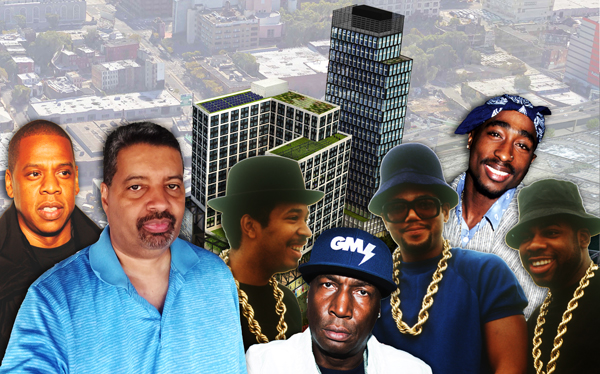In the spring of 2014, Universal Hip Hop Museum executive director Rocky Bucano received an unusual phone call from the security guard at his gated community in Clason Point. A busload of Japanese tourists was at the gates. They were under the impression that it was the site of the hip-hop museum itself.
A baffled Bucano soon realized that he had done something rather naïve: he listed his home address as the museum’s address on the organization’s Facebook page.
“I used it as a mailing address, not knowing that people would think the museum was actually at my home,” he said. “I had to go outside and basically tell the security guard to tell them that the museum is not here.”
The museum is still not at Bucano’s house, nor is it at a host of other sites that museum officials and developers tried to make work, ranging from the Kingsbridge Armory to the old Bronx Borough Courthouse to even Newark, New Jersey. And though it probably won’t be ready for tour buses until at least 2022, it does now finally have a home at L+M Development Partners’ upcoming megaproject along the South Bronx waterfront.
It took about four years of searching and unsuccessful negotiations with real estate players including Youngwoo & Associates, and Henry Weinstein before the museum successfully found space at L+M’s project, which will also feature more than 1,000 units of affordable housing and a multiplex theater. Several companies the museum had talked with earlier expressed disappointment that their efforts at making a deal had fallen short, but Bucano was just thrilled to finally have a space for his project.
“I was born and raised in the Bronx. I’ve lived here for 57 years. I know what hip-hop means to the borough. I know what hip-hop means to the city of New York,” he said. “And I just couldn’t see having a hip-hop museum anywhere else but the Bronx.”
False start
The exact birthplace of hip-hop will always be up for debate, but the most widely accepted date and time is Aug. 11, 1973 at 1520 Sedgwick Avenue, where Kool Herc showed off a new way to D.J. at a birthday party for his sister. The genre has exploded into an international phenomenon in the decades since, but several of its early pioneers were based in the Bronx, including Grandmaster Flash and Afrika Bambaataa.
The idea for the Universal Hip Hop Museum started in response to a Request for Proposals that the city had issued for the Kingsbridge Armory. Bucano was a member of the New York Gauchos basketball program at the time and had been interested in using the armory as space for the group. This led to a meeting with Youngwoo & Associates, which was putting together a bid for the space.
Youngwoo liked the idea of bringing the basketball team to the armory and the company asked Bucano about adding some type of music component to their bid as well to make it stand out more.
“I said, you know, everybody’s been trying to get a hip-hop museum started,” Bucano said, “and this would be an ideal opportunity to create a space for a hip-hop museum.”
Youngwoo loved the idea, according to Bryan Woo, executive vice president of the company.
“We were really excited about that,” he said. “The whole story about the Bronx being the birthplace of hip-hop would have been wonderful.”
Though Youngwoo submitted a bid for the project, the city chose a different plan from former New York Rangers star Mark Messier and his group to turn the armory into a sports facility known as the Kingsbridge National Ice Center.
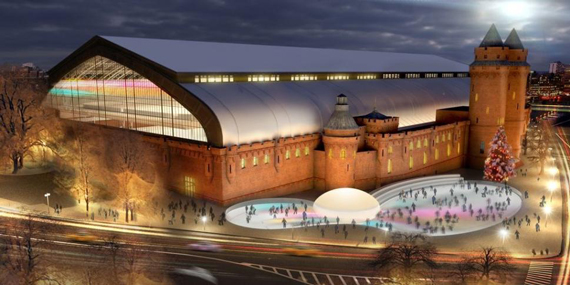
Rendering of the Kingsbridge Armory
Youngwoo is now at work on another major Bronx project—redeveloping the Bronx General Post Office — but Woo said their missed opportunity to work on the armory site and hip-hop museum still stings. The company had discussions about reconnecting with the Universal Hip Hop Museum to have them set up shop at the post office but eventually decided they could not make the space work.
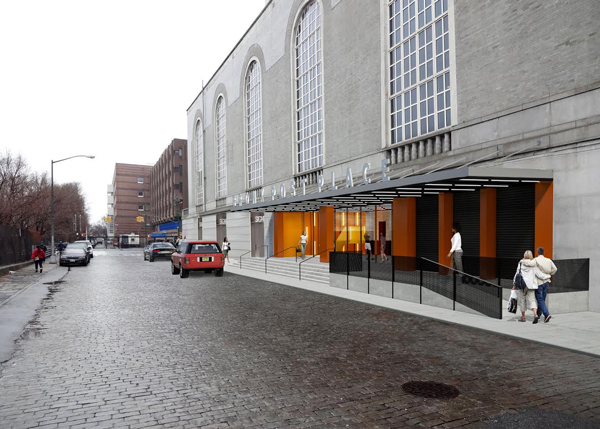
Rendering of the Bronx General Post Office (Credit: Studio V)
“We thought about trying to figure out a way to get it in there, but I think ultimately just the size of what they needed and how much rent they could pay, it didn’t pan out,” he said. “It would have really worked for the armory. It really would have worked out over there, and it really is a terrible shame it didn’t happen.”
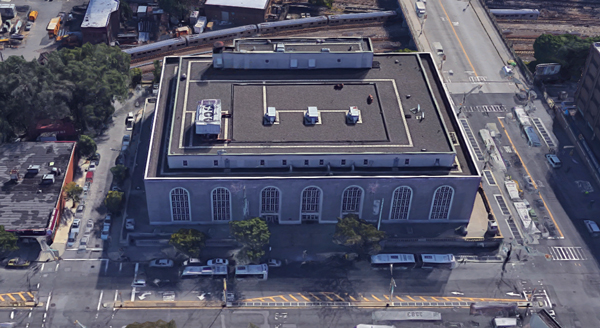
Current site of the Bronx General Post Office (Credit: Google Maps)
The search continues
Museum organizers kept searching for a site after the armory failure, next taking a look at the Kelly’s Furniture Building On Bruckner Boulevard. But the space was too big and the building needed too much work, Buscano said.
They also considered looking outside of New York, despite hip-hop’s roots in the city. Bucano said they explored putting the museum in Newark, but nothing came together there, either.
In 2015, he turned his attention to the Old Bronx Borough Courthouse, a long-vacant building at East 161st Street and Third Avenue.
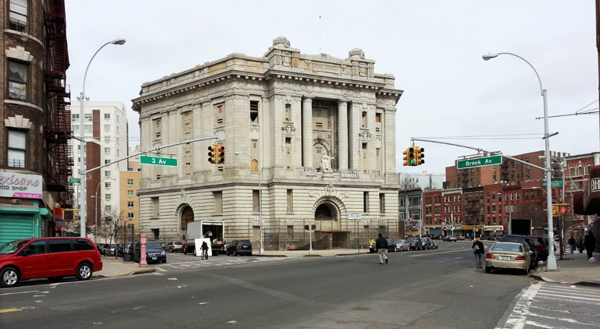
The Old Bronx Courthouse (Credit: Manu ツ via Google+)
Henry Weinstein, one of the owners of the building, thought the courthouse would have been a perfect fit for the museum. But this plan ended up falling through as well, largely for financial reasons.
“Henry had made a significant investment in the courthouse, and he was looking for a tenant, and we were not in a position to be anyone’s tenant,” Bucano said. “We were looking to own our space, and unless we were able to own our space, there was really no discussion to be had.”
Weinstein had a different take on it.
“They didn’t have the finances,” he said. “They didn’t have any money, period.”
The courthouse eventually found its tenant in a new Success Academy that Weinstein said aims to open in summer 2018. He is happy with how things worked out for both parties, but like Woo at the post office site, he still maintains that the hip-hop museum would have looked great in the courthouse.
“We had a terrific space,” he said. “I think it would have been a great space for it.”
Success beckons
In the summer of 2016, the city released a request for expressions of interest that would work out much better for the museum than the armory request.
This time, the Economic Development Corporation was seeking plans for an affordable housing project with commercial and community space located along the South Bronx waterfront by Mill Pond Park and the 145th Street Bridge. L+M wanted to put in a bid for the project, and the company was looking for some sort of “cultural anchor” that would draw people to the site and drum up excitement about the development, according to project director Josue Sanchez.
“Thinking out loud among the team members, I mentioned, ‘What about a hip-hop museum?’” Sanchez said. “It’s sort of an obvious idea in the Bronx. I don’t think anyone will question that’s where it belongs: in the South Bronx.”
L+M quickly got on board with the idea, but given the borough’s well-known reputation as the birthplace of hip-hop, Sanchez assumed he was not the first person who had thought of doing this. He started searching around online to see what was already out there, and when he came across the Universal Hip Hop Museum, he figured it was worth looking into.
“Rocky got back to me, and we started talking, and that’s where it started,” Sanchez said.
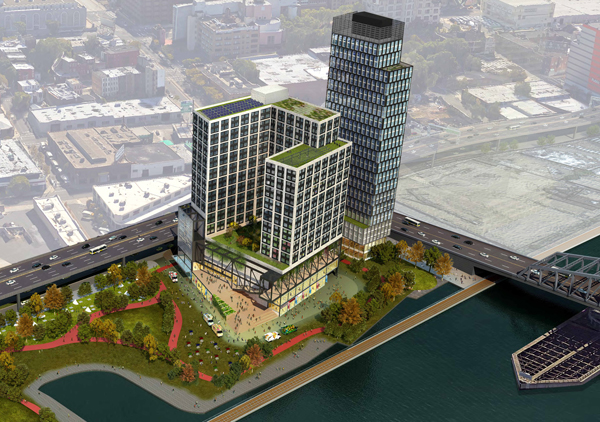
A rendering of Bronx Point (Credit: S9 Architecture)
Bucano liked the location’s proximity to Yankee Stadium and multiple subway lines, while L+M figured that including a hip-hop museum in their project would capture the attention of city officials and also drive visitors to the site.
“The hip-hop museum sort of checked a lot of boxes,” Sanchez said. “It will bring not only a local crowd but international guests even.”
L+M ultimately decided to include the museum in its proposal, which the city announced as the winning bid in late September. The museum is expected to occupy about 60,000 square feet across the first two floors of the project, and the design is still in the planning stages. Its space will be equivalent to a condo, and while the two parties are still working out the details of the finances, Bucano said there would likely be some type of lease transfer for $1.
Museum officials still have their work cut out for them going forward, especially when it comes to fundraising. Bucano estimated that the museum will cost anywhere between $36 and $60 million, but the organization had just $20,000 in total revenue and $10,000 in total assets as of fiscal year 2017, according to its financial statements. Bucano said the group’s revenue has since increased to about $45,000 and expects to rely largely on a combination of public funding, corporate sponsors and private donations moving forward.
He anticipates the museum will not open until 2022 or 2023 but already has a lengthy list of luminaries who he would like to see there when the day finally comes, ranging from early pioneers like Grandmaster Flash and Lovebug Starski to modern stars like Drake and Kendrick Lamar.
“Everybody and anybody that has made a name for themselves in hip-hop,” he said, “they should be at that grand opening.”
